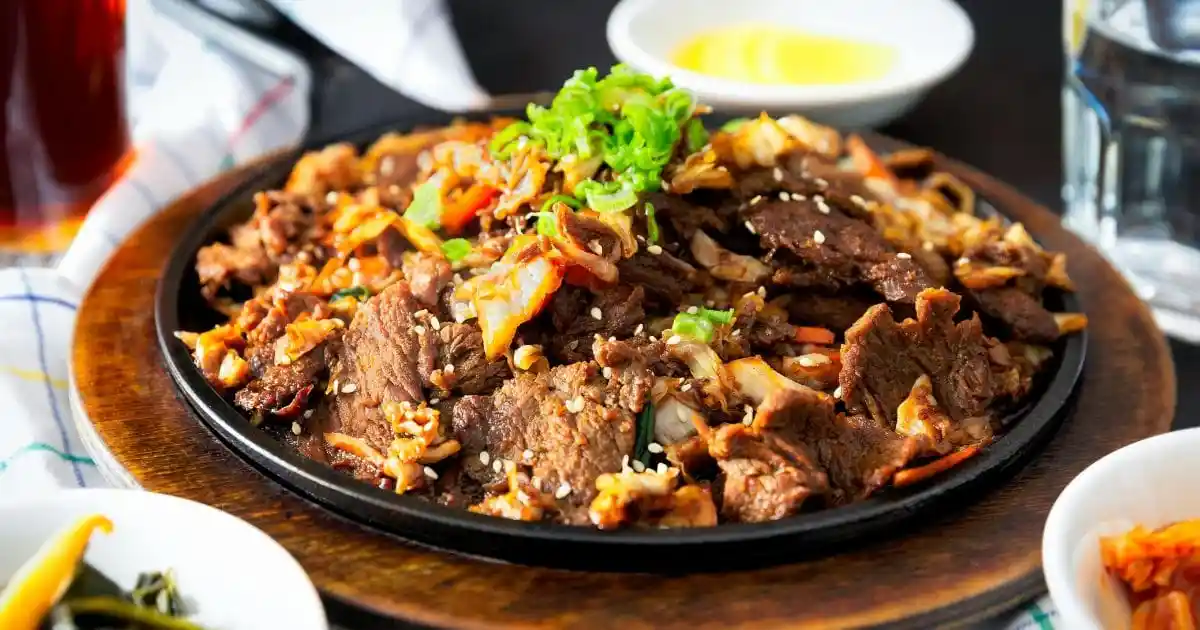Easy Beef Bulgogi Recipe
Table of Contents
Easy Beef Bulgogi Recipe for Quick and Delicious Meals
Explore the tasty world of Korean BBQ with our simple beef bulgogi recipe. Bulgogi is a classic Korean dish with thinly sliced marinated beef. It’s a mix of sweet and savory flavors. This recipe is perfect for anyone, whether you love Korean food or are new to Asian flavors.
In less than 30 minutes, you can make a delicious bulgogi. It’s great for a quick dinner or a weekend meal with family and friends. The tender beef and amazing smell will make it a hit at home.
Key Takeaways
- Discover the mouthwatering world of Korean BBQ with this simple and flavorful beef bulgogi recipe
- Enjoy a delightful balance of sweet and savory flavors in this classic Korean dish
- Prepare a satisfying and authentic-tasting bulgogi in under 30 minutes
- Impress your family and friends with this easy-to-follow, crowd-pleasing recipe
- Elevate your weeknight dinners or weekend gatherings with this delicious Korean BBQ-inspired meal
What is Beef Bulgogi: Understanding Korean BBQ Basics
Korean cuisine is rich and vibrant, with bulgogi being a key dish. It comes from “bul” meaning fire and “gogi” meaning meat. Beef bulgogi is a favorite in Korean food culture, showing the country’s unique flavors and traditions.
Origins and Cultural Significance
Beef bulgogi’s roots go back to the Goguryeo dynasty. Back then, marinated and grilled meats were a royal favorite. Over time, this dish has changed, showing how Korean food has been influenced by many cultures. Its popularity shows how much it represents Korean food’s heart and soul.
Traditional vs Modern Preparation Methods
- Traditionally, beef was thinly sliced and marinated in soy sauce, sugar, garlic, and more before grilling.
- Nowadays, people use different methods like pan-frying or oven-roasting. This makes cooking easier and faster.
- Even with these changes, bulgogi’s cultural importance remains strong. It’s still a favorite in Korea, showing the country’s rich food heritage.
As Korean food becomes more popular globally, beef bulgogi’s charm is winning over food lovers everywhere. From its simple start to its current fame, this dish opens a window into Korean cuisine history, bulgogi origin, and cultural food that shape Korea’s food identity.
Essential Ingredients for Authentic Beef Bulgogi
Learning to make beef bulgogi starts with knowing the key ingredients. These ingredients give the dish its unique taste and texture. Each part is important for a delicious bulgogi experience.
The heart of a bulgogi marinade is soy sauce, sesame oil, and Asian pear. Soy sauce adds a savory umami flavor. Sesame oil brings a rich, toasted nuttiness. Grated Asian pear tenderizes the beef and adds a sweet touch.
Garlic and onion add bold, pungent flavors to the meat. These Korean seasonings are often mixed with brown sugar or honey. This makes the grilled or pan-seared bulgogi even tastier.
The right beef cut is key for the perfect texture. Thinly sliced ribeye or tenderloin are best for tender bites. But flank steak or sirloin offer a chewier texture.
Using the right mix of Asian pantry staples brings out the true flavor of beef bulgogi. It can take your cooking to new levels.
How to Make Bulgogi: Step-by-Step Instructions
Making a delicious beef bulgogi dish is all about choosing the right meat, making a great marinade, and cooking it just right. Follow these steps to make your bulgogi taste amazing. Enjoy the rich flavors of this Korean dish.
Meat Selection and Preparation
The key to a great bulgogi is the meat. Use thinly sliced beef slicing like sirloin or ribeye. They are tender and full of flavor. Slice the meat thinly for even cooking and a soft texture.
Marinade Creation Tips
A good bulgogi marinade recipe has the right mix of savory, sweet, and aromatic flavors. Mix soy sauce, brown sugar, garlic, ginger, and sesame oil. Let the meat marinate for at least 30 minutes, or up to 8 hours, for the best taste.
Cooking Techniques
You can cook your bulgogi by grilling or pan-frying. Both ways are tasty, but it’s up to you. Make sure to cook at the right temperature. This will give the beef a nice caramelized crust.
| Cooking Method | Recommended Temperature | Time |
|---|---|---|
| Grilling | High heat (450°F – 500°F) | 3-5 minutes per side |
| Pan-Frying | Medium-high heat | 4-6 minutes per side |
By following these steps, you’ll make a tasty beef bulgogi dish. It will impress everyone. Enjoy the flavors and tender texture of this Korean dish.
Perfect Marinade Recipe for Tender, Flavorful Beef
Take your beef bulgogi to the next level with a top-notch marinade. This recipe brings together flavors and tenderness in perfect harmony. Discover the secret to delicious Korean barbecue right in your kitchen.
The bulgogi sauce is all about balance. Soy sauce gives it a savory base, while brown sugar adds a hint of sweetness. The Asian pear is the game-changer, tenderizing the meat and adding a fruity touch.
- In a large bowl, whisk together 1/2 cup soy sauce, 1/4 cup brown sugar, 2 tablespoons grated Asian pear, 3 cloves minced garlic, and 1 tablespoon sesame oil.
- Add 2 pounds of thinly sliced beef (such as flank steak or ribeye) to the marinade and toss to coat evenly.
- Cover the bowl and refrigerate for at least 2 hours, or up to 24 hours for maximum flavor and tenderness.
Customize the marinade to your liking. Add more soy sauce for a saltier taste or brown sugar for sweetness. The goal is to enhance the beef’s natural flavors and make your meal unforgettable.
Best Cooking Methods and Temperature Guide
Choosing between pan-frying and grilling is key for making great bulgogi. Each method brings its own benefits. You can get the perfect mix of taste and texture in your Korean BBQ meals.
Pan-Frying vs Grilling
Pan-frying bulgogi is easy and popular for home cooks. It lets you control the heat well. This ensures the meat cooks evenly and gets a nice crust.
Grilling, however, adds a smoky flavor that’s loved in Korean BBQ. It gives the meat a chargrilled taste.
Temperature Control Tips
- For pan-frying, use medium-high heat (350-400°F) to sear the meat and keep juices in.
- Grill bulgogi at medium-high heat (400-450°F) for the best char without overcooking.
Achieving the Perfect Char
Getting the right char on bulgogi takes time and skill. Whether pan-frying or grilling, watch the meat closely. Control the heat to prevent burning or overcooking.
| Cooking Method | Optimal Cooking Time | Desired Internal Temperature |
|---|---|---|
| Pan-Frying | 3-5 minutes per side | 145-155°F |
| Grilling | 2-4 minutes per side | 145-155°F |
Mastering temperature control and cooking techniques can make your bulgogi dishes amazing. Try both pan-frying and grilling to find your favorite way to make delicious Korean BBQ at home.
Side Dishes and Serving Suggestions
Enjoying Korean beef bulgogi is better with the right side dishes, called Korean side dishes or banchan. These dishes add flavor and balance to the meal. They complement the bold taste of the beef.
In Korean homes, banchan is served with bulgogi. This lets everyone make their own mix of flavors. Some favorite Korean side dishes include:
- Kimchi, the spicy fermented cabbage
- Seasoned spinach or other greens for a fresh taste
- Fishcakes or japchae for a chewy texture
- Pickled radish or cucumber for a tangy crunch
Try serving bulgogi in a lettuce wrap for a modern twist. It mixes well with the fresh lettuce. Serve it with steamed rice for a full Korean meal.
| Traditional Banchan | Serving Suggestions |
|---|---|
| Kimchi | Spicy, fermented cabbage |
| Seasoned Spinach | Crisp and refreshing contrast |
| Fishcakes | Chewy and savory element |
| Pickled Radish | Crunchy and acidic balance |
Adding these Korean side dishes and bulgogi accompaniments makes your meal authentic. You can enjoy a real Korean dining experience at home.

Storage Tips and Meal Prep Options
After enjoying your homemade beef bulgogi, you might have leftovers. It’s important to store them right to keep the taste and texture great. Refrigerate any leftover bulgogi in an airtight container for 3-4 days. If you want to store it for a longer period, you can freeze it for 2-3 months.
Proper Storage Guidelines
Let your bulgogi cool down completely before putting it in a container. This step helps keep the flavors and prevents bacteria. You can also freeze it in portions for easy meals. Just use freezer-safe bags or containers and remove air to avoid freezer burn.
Reheating Methods
To reheat your bulgogi, choose a method that keeps it moist. The microwave is quick but can dry out the meat. Instead, reheat it gently in a skillet with a bit of water or broth.
You can also warm it up in the oven or on the stovetop. This way, the meat stays tender and flavorful.
FAQ
What is the origin and cultural significance of beef bulgogi?
Beef bulgogi is a beloved Korean dish with a long history. It comes from the Korean peninsula and is a national favorite. The name “bulgogi” means “fire-grilled meat.” It has become popular worldwide, loved for its unique taste.
What are the essential ingredients for authentic beef bulgogi?
To make real beef bulgogi, you need thinly sliced beef, soy sauce, and brown sugar. Also, sesame oil, garlic, onion, and Asian pear are key. These ingredients mix to create the dish’s famous sweet and savory taste.
How do I prepare the perfect beef bulgogi marinade?
For the best marinade, mix soy sauce, brown sugar, sesame oil, garlic, and Asian pear. This blend tenderizes the beef and adds Korean flavors. Let the beef marinate for at least 30 minutes or up to 24 hours for the best taste and tenderness.
What are the best cooking methods for beef bulgogi?
Beef bulgogi can be cooked by pan-frying or grilling. Pan-frying gives a nice sear, while grilling adds a charred taste. Always cook at high heat to get the right texture and flavor.
What are some traditional Korean side dishes that pair well with beef bulgogi?
Great Korean side dishes for beef bulgogi include kimchi, sautéed spinach, bean sprout salad, and steamed rice. These dishes complement the bold bulgogi flavors, offering a complete Korean meal.
How can I store and reheat leftover beef bulgogi?
Store leftover bulgogi in an airtight container in the fridge for 3-4 days. To reheat, use a skillet or microwave. Add water or broth to keep it moist.
Tried This Recipe? Leave Your Review!
There are no reviews yet. Be the first one to write one.

